PANASONIC DMC-LZ2PP, DMC-LZ2PL, DMC-LZ2EB, DMC-LZ2EG, DMC-LZ2EGM Service Manual
...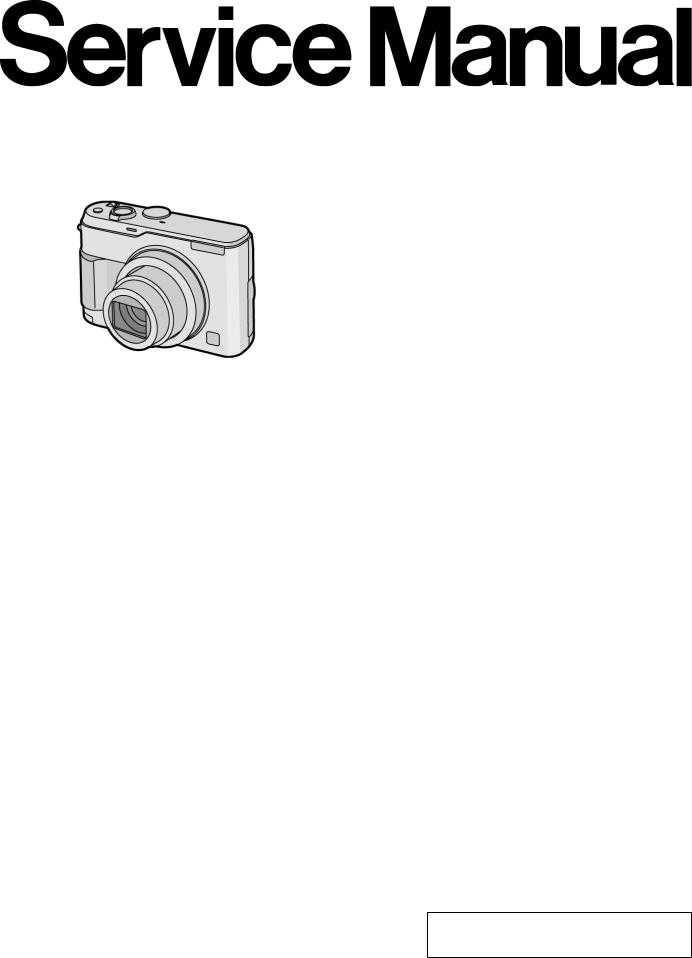
ORDER NO. DSC0502001C0
B26
Digital Camera
DMC-LZ2PP
DMC-LZ2PL
DMC-LZ2EB
DMC-LZ2EG
DMC-LZ2EGM
DMC-LZ2GC
DMC-LZ2GD
DMC-LZ2GK
DMC-LZ2GN
DMC-LZ2GT
DMC-LZ2SG
DMC-LZ1PP
DMC-LZ1PL
DMC-LZ1EB
DMC-LZ1EG
DMC-LZ1EGM
DMC-LZ1GC
DMC-LZ1GD
DMC-LZ1GK
DMC-LZ1GN
DMC-LZ1GT
Vol. 1
Colour DMC-LZ2
(S)...........Silver Type
(K)...........Black Type (PP,EB,EG,EGM and GC only) DMC-LZ1
(S)...........Silver Type
© 2005 Matsushita Electric Industrial Co., Ltd. All rights reserved. Unauthorized copying and distribution is a violation of law.
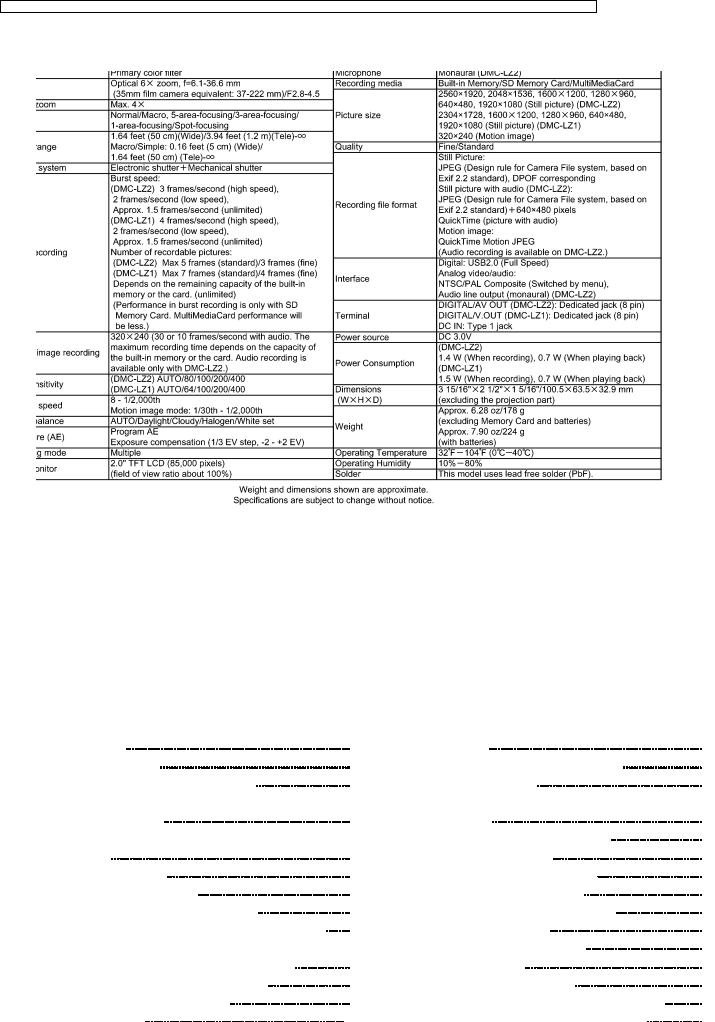
DMC-LZ2PP / DMC-LZ2PL / DMC-LZ2EB / DMC-LZ2EG / DMC-LZ2EGM / DMC-LZ2GC / DMC-LZ2GD / DMC-LZ2GK / DMC-LZ2GN / DMC-LZ2GT / DMC-LZ2SG
CONTENTS
|
Page |
|
|
Page |
|
1 |
INTRODUCTION |
4 |
6 |
SERVICE NOTES |
13 |
|
1.1. INTRODUCTION |
4 |
|
6.1. WHEN REPLACING THE MAIN C.B.A. |
13 |
|
1.2. ABOUT LEAD FREE SOLDER (PbF) |
4 |
|
6.2. SERVICE POSITION |
13 |
|
1.3. IMPORTANT NOTICE 1: (Other than U.S.A. and |
|
|
6.3. HOW TO DISCHARGE THE CAPACITOR ON FLASH |
|
|
Canadian Market) |
4 |
|
TOP C.B.A. |
14 |
|
1.4. HOW TO DEFINE THE MODEL SUFFIX (NTSC or PAL |
|
|
6.4. CLEANING LENS AND LCD PANEL |
14 |
|
model) |
5 |
7 |
ADJUSTMENT PROCEDURES |
15 |
2 |
SAFETY PRECAUTIONS |
7 |
|
7.1. SERVICE FIXTURE AND TOOLS |
16 |
|
2.1. GENERAL GUIDELINES |
7 |
8 |
ERROR CODE MEMORY FUNCTION |
17 |
|
2.2. LEAKAGE CURRENT COLD CHECK |
7 |
9 |
CONFIRMATION OF FIRMWARE VERSION |
20 |
|
2.3. LEAKAGE CURRENT HOT CHECK (See Figure 1.) |
7 |
10 |
DISASSEMBLY PROCEDURE |
21 |
3 |
PREVENTION OF ELECTRO STATIC DISCHARGE (ESD) TO |
|
|
10.1. DISASSEMBLY FLOW CHART |
21 |
|
ELECTROSTATICALLY SENSITIVE (ES) DEVICES |
8 |
|
10.2. C.B.A. LOCATION |
21 |
4 |
HOW TO REPLACE THE LITHIUM BATTERY |
9 |
|
10.3. DIASSEMBLY PROCEDURE |
22 |
|
4.1. REPLACEMENT PROCEDURE |
9 |
|
10.4. DISASSEMBLY PROCEDURE FOR THE LENS |
26 |
5 |
OPERATING GUIDE |
11 |
|
10.5. ASSEMBLY PROCEDURE FOR THE LENS |
28 |
2

DMC-LZ2PP / DMC-LZ2PL / DMC-LZ2EB / DMC-LZ2EG / DMC-LZ2EGM / DMC-LZ2GC / DMC-LZ2GD / DMC-LZ2GK / DMC-LZ2GN / DMC-LZ2GT / DMC-LZ2SG
|
10.6. REMOVAL OF THE CCD |
31 |
|
12.1. CCD C.B.A. |
37 |
|
10.7. THE APPLYMENT OF GREASE METHOD |
32 |
|
12.2. FLASH TOP C.B.A. |
38 |
11 |
SCHEMATIC DIAGRAMS |
33 |
|
12.3. LENS FLEX C.B.A. |
39 |
|
11.1. OVERALL BLOCK DIAGRAM |
33 |
13 |
EXPLODED VIEWS |
40 |
|
11.2. WIRING CONNECTION DIAGRAM |
34 |
|
13.1. FRAME & CASING SECTION |
40 |
|
11.3. FLASH TOP SCHEMATIC DIAGRAM |
35 |
|
13.2. PACKING PARTS & ACCESSORIES SECTION |
42 |
|
11.4. CCD SCHEMATIC DIAGRAM |
35 |
14 |
REPLACEMENT PARTS LIST |
43 |
|
11.5. LENS FLEX SCHEMATIC DIAGRAM |
36 |
|
14.1. MECHANICAL REPLACEMENT PARTS LIST |
43 |
12 |
CIRCUIT BOARD ASSEMBLIES |
37 |
|
14.2. ELECTRICAL REPLACEMENT PARTS LIST |
45 |
3

DMC-LZ2PP / DMC-LZ2PL / DMC-LZ2EB / DMC-LZ2EG / DMC-LZ2EGM / DMC-LZ2GC / DMC-LZ2GD / DMC-LZ2GK / DMC-LZ2GN / DMC-LZ2GT / DMC-LZ2SG
1 INTRODUCTION
1.1.INTRODUCTION
This service manual contains technical information, which allow service personnel’s to understand and service this model. Please place orders using the parts list and not the drawing reference numbers.
If the circuit is changed or modified, the information will be followed by service manual to be controlled with original service manual.
1.2.ABOUT LEAD FREE SOLDER (PbF)
Distinction of PbF PCB:
PCBs (manufactured) using lead free solder will have a PbF stamp on the PCB.
Caution:
·Pb free solder has a higher melting point than standard solder, Typically the melting point is 50-70°F (30-40°C) higher.
Please use a high temperature soldering iron. In case of soldering iron with temperature control, please set it to 700±20°F (370±10°C)
·Pb free solder will tend to splash when heated too high (about 1100°F/600°C).
When soldering or unsoldering, please completely remove all of the solder on the pins or solder area, and be sure to heat the soldering points with the Pb free solder until it melts enough.
1.3.IMPORTANT NOTICE 1: (Other than U.S.A. and Canadian Market)
1.The service manual does not contain the following information, because of the impossibility of servicing at component level.
a.Schematic diagram, Block Diagram and C.B.A. layout of Main C.B.A.
b.Parts list for individual parts of Main C.B.A.
When a part replacement is required for repairing Main C.B.A., replace as an assembled parts. (Main C.B.A.)
2.The following category is/are recycle module part. please send it/them to Central Repair Center.
·MAIN C.B.A. (DMC-LZ2: VEP56019B, DMC-LZ1: VEP56019A) : Excluding replacement of Lithium Battery
4
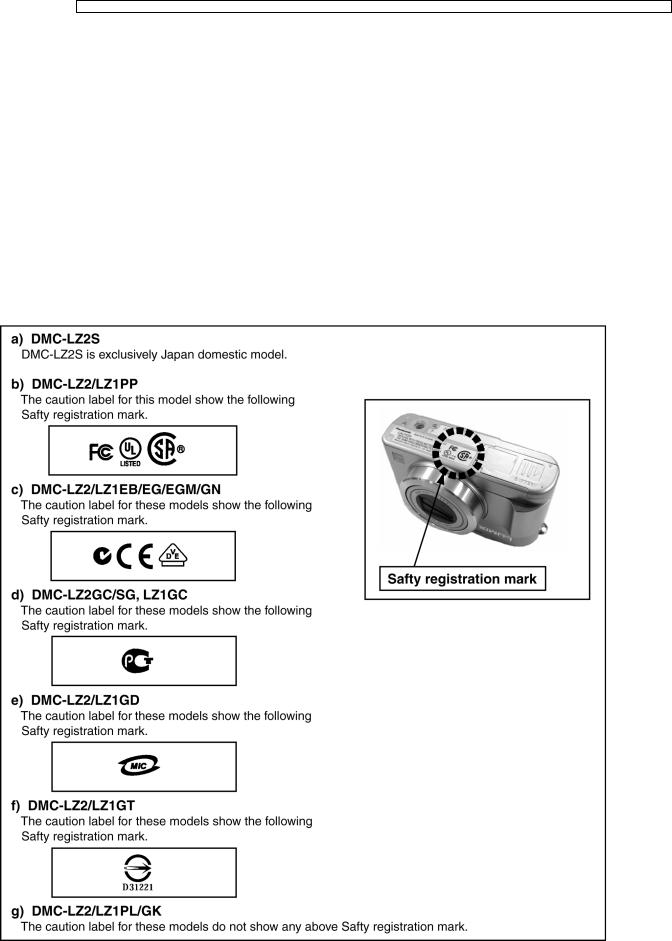
DMC-LZ2PP / DMC-LZ2PL / DMC-LZ2EB / DMC-LZ2EG / DMC-LZ2EGM / DMC-LZ2GC / DMC-LZ2GD / DMC-LZ2GK / DMC-LZ2GN / DMC-LZ2GT / DMC-LZ2SG
1.4.HOW TO DEFINE THE MODEL SUFFIX (NTSC or PAL model)
There are seven kinds of DMC-LZ2/LZ1, regardless the colours.
·DMC-LZ2S
·DMC-LZ2/LZ1PP
·DMC-LZ2/LZ1EB/EG/EGM/GN
·DMC-LZ2GC/SG, LZ1GC
·DMC-LZ2/LZ1GD
·DMC-LZ2/LZ1GT
·DMC-LZ2/LZ1PL/GK
(DMC-LZ2S is exclusively Japan domestic model.)
What is the difference is that the “INITIAL SETTING” data which is stored in Flash ROM mounted on Main C.B.A.
1.4.1.Defining methods:
To define the model suffix to be serviced, refer to the caution label which is putted on the bottom side of the Unit.
NOTE:
After replacing the MAIN C.B.A., be sure to achieve adjustment.
The adjustment instruction is available at “software download” on the “CS-Web from AVC” web-site in “TSN system”.
5

DMC-LZ2PP / DMC-LZ2PL / DMC-LZ2EB / DMC-LZ2EG / DMC-LZ2EGM / DMC-LZ2GC / DMC-LZ2GD / DMC-LZ2GK / DMC-LZ2GN / DMC-LZ2GT / DMC-LZ2SG
1.4.2.INITIAL SETTINGS:
When you replace the Main C.B.A., be sure to perform the initial settings after achieving the Adjustment, by ordering the following procedure in accordance with model suffix.
· Step 1. The temporary cancellation of factory setting:
Set the mode dial to “ |
|
Normal Picture |
(Red camera mark)”. |
||||
While keep pressing |
|
|
and “ |
|
of Cross key” simultaneously, turn the Power on. |
||
|
Optical Image Stabilizer |
UP |
|||||
· Step 2. The cancellation of factory setting:
Set the mode dial to “ Playback ”.
While keep pressing Optical Image Stabilizer and “ UP of Cross key” simultaneously, turn the Power off.
· Step 3. Turn the Power on:
Set the mode dial to “ |
|
Normal Picture |
(Red camera mark)”, and then turn the Power on. |
||||
· Step 4. Display the INITIAL SETTING: |
|||||||
While keep pressing |
|
|
and “ |
|
of Cross key” simultaneously, turn the Power off. |
||
|
MENU |
RIGHT |
|||||
· Step 5. Set the INITIAL SETTING:
Select the area with pressing “ UP / DOWN of Cross key”, and then press the “ RIGHT of Cross key”.
The only set area is displayed, and then press the " RIGHT of Cross key" after confirmation. (The unit is powered off automatically.)
Confirm the display of “PLEASE SET THE CLOCK” in English when the unit is turned on again. (For China and Taiwan market, the display shows “PLEASE SET THE CLOCK” in Chinese.)
·NOTE:
The display shows “SET THE CLOCK” when turn the Power on again. Connect the unit to PC with USB cable and is detected as removable media.
1)As for your reference Default setting condition is given in the following table.
·Default setting (After “INITIAL SETTINGS”)
|
MODEL |
VIDEO OUTPUT |
LANGUAGE |
DATE |
REMARKS |
a) |
DMC-LZ2S |
NTSC |
Japanese |
Year/Month/Date |
|
b) |
DMC-LZ2/1PP/PL |
NTSC |
English |
Month/Date/Year |
|
c) |
DMC-LZ2/1EB/EG/EGM/GC/GN/SG |
PAL |
English |
Date/Month/Year |
SG=DMC-FZ2 only |
d) |
DMC-LZ2/1GK |
PAL |
Chinese (simplified) |
Year/Month/Date |
|
e) |
DMC-LZ2/1GT |
NTSC |
Chinese (traditional) |
Year/Month/Date |
|
f) |
DMC-LZ2/1GD |
NTSC |
English |
Year/Month/Date |
|
6

DMC-LZ2PP / DMC-LZ2PL / DMC-LZ2EB / DMC-LZ2EG / DMC-LZ2EGM / DMC-LZ2GC / DMC-LZ2GD / DMC-LZ2GK / DMC-LZ2GN / DMC-LZ2GT / DMC-LZ2SG
2 SAFETY PRECAUTIONS
2.1.GENERAL GUIDELINES
1.IMPORTANT SAFETY NOTICE
There are special components used in this equipment which are important for safety. These parts are marked by
 in the Schematic Diagrams, Circuit Board Layout, Exploded Views and Replacement Parts List. It is essential that these critical parts should be replaced with manufacturer’s specified parts to prevent X-RADIATION, shock, fire, or other hazards. Do not modify the original design without permission of manufacturer.
in the Schematic Diagrams, Circuit Board Layout, Exploded Views and Replacement Parts List. It is essential that these critical parts should be replaced with manufacturer’s specified parts to prevent X-RADIATION, shock, fire, or other hazards. Do not modify the original design without permission of manufacturer.
2.An Isolation Transformer should always be used during the servicing of AC Adaptor whose chassis is not isolated from the AC power line. Use a transformer of adequate power rating as this protects the technician from accidents resulting in personal injury from electrical shocks. It will also protect AC Adaptor from being damaged by accidental shorting that may occur during servicing.
3.When servicing, observe the original lead dress. If a short circuit is found, replace all parts which have been overheated or damaged by the short circuit.
4.After servicing, see to it that all the protective devices such as insulation barriers, insulation papers shields are properly installed.
5.After servicing, make the following leakage current checks to prevent the customer from being exposed to shock hazards.
2.2.LEAKAGE CURRENT COLD CHECK
2.3.LEAKAGE CURRENT HOT CHECK (See Figure 1.)
1.Plug the AC cord directly into the AC outlet. Do not use an isolation transformer for this check.
2.Connect a 1.5 kΩ, 10 W resistor, in parallel with a 0.15 µF capacitor, between each exposed metallic part on the set and a good earth ground, as shown in Figure 1.
3.Use an AC voltmeter, with 1 kΩ/V or more sensitivity, to measure the potential across the resistor.
4.Check each exposed metallic part, and measure the voltage at each point.
5.Reverse the AC plug in the AC outlet and repeat each of the above measurements.
6.The potential at any point should not exceed 0.75 V RMS. A leakage current tester (Simpson Model 229 or equivalent) may be used to make the hot checks, leakage current must not exceed 1/2 mA. In case a measurement is outside of the limits specified, there is a possibility of a shock hazard, and the equipment should be repaired and rechecked before it is returned to the customer.
1.Unplug the AC cord and connect a jumper between the two prongs on the plug.
2.Measure the resistance value, with an ohmmeter, between the jumpered AC plug and each exposed metallic cabinet part on the equipment such as screwheads, connectors, control shafts, etc. When the exposed metallic part has a return path to the chassis, the reading should be between 1 MΩ and 5.2 MΩ. When the exposed metal does not have a return path to the chassis, the reading must be infinity.
7

DMC-LZ2PP / DMC-LZ2PL / DMC-LZ2EB / DMC-LZ2EG / DMC-LZ2EGM / DMC-LZ2GC / DMC-LZ2GD / DMC-LZ2GK / DMC-LZ2GN / DMC-LZ2GT / DMC-LZ2SG
3 PREVENTION OF ELECTRO STATIC DISCHARGE (ESD) TO ELECTROSTATICALLY SENSITIVE (ES) DEVICES
Some semiconductor (solid state) devices can be damaged easily by static electricity. Such components commonly are called Electrostatically Sensitive (ES) Devices. Examples of typical ES devices are integrated circuits and some field-effect transistors and semiconductor "chip" components. The following techniques should be used to help reduce the incidence of component damage caused by electro static discharge (ESD).
1.Immediately before handling any semiconductor component or semiconductor-equipped assembly, drain off any ESD on your body by touching a known earth ground. Alternatively, obtain and wear a commercially available discharging ESD wrist strap, which should be removed for potential shock reasons prior to applying power to the unit under test.
2.After removing an electrical assembly equipped with ES devices, place the assembly on a conductive surface such as aluminum foil, to prevent electrostatic charge buildup or exposure of the assembly.
3.Use only a grounded-tip soldering iron to solder or unsolder ES devices.
4.Use only an antistatic solder removal device. Some solder removal devices not classified as "antistatic (ESD protected)" can generate electrical charge sufficient to damage ES devices.
5.Do not use freon-propelled chemicals. These can generate electrical charges sufficient to damage ES devices.
6.Do not remove a replacement ES device from its protective package until immediately before you are ready to install it. (Most replacement ES devices are packaged with leads electrically shorted together by conductive foam, aluminum foil or comparable conductive material).
7.Immediately before removing the protective material from the leads of a replacement ES device, touch the protective material to the chassis or circuit assembly into which the device will be installed.
CAUTION :
Be sure no power is applied to the chassis or circuit, and observe all other safety precautions.
8.Minimize bodily motions when handling unpackaged replacement ES devices. (Otherwise harmless motion such as the brushing together of your clothes fabric or the lifting of your foot from a carpeted floor can generate static electricity (ESD) sufficient to damage an ES device).
8
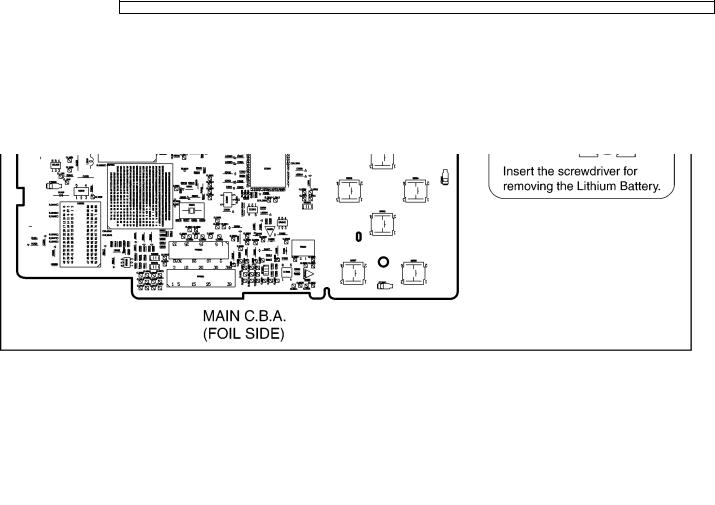
DMC-LZ2PP / DMC-LZ2PL / DMC-LZ2EB / DMC-LZ2EG / DMC-LZ2EGM / DMC-LZ2GC / DMC-LZ2GD / DMC-LZ2GK / DMC-LZ2GN / DMC-LZ2GT / DMC-LZ2SG
4 HOW TO REPLACE THE LITHIUM BATTERY
4.1.REPLACEMENT PROCEDURE
1.Remove the MAIN C.B.A. (Refer to Disassembly Procedures.)
2.Remove the Lithium battery (Ref. No. “Z9101” at foil side of MAIN C.B.A.) and then replace it into new one.
NOTE:
This Lithium battery is a critical component.
(Type No.: ML-614S/ZT Manufactured by Matsushita Battery Industrial Co.,Ltd.) It must never be subjected to excessive heat or discharge.
It must therefore only be fitted in requirement designed specifically for its use. Replacement batteries must be of same type and manufacture.
They must be fitted in the same manner and location as the original battery, with the correct polarity contacts observed. Do not attempt to re-charge the old battery or re-use it for any other purpose.
It should be disposed of in waste products destined for burial rather than incineration.
9
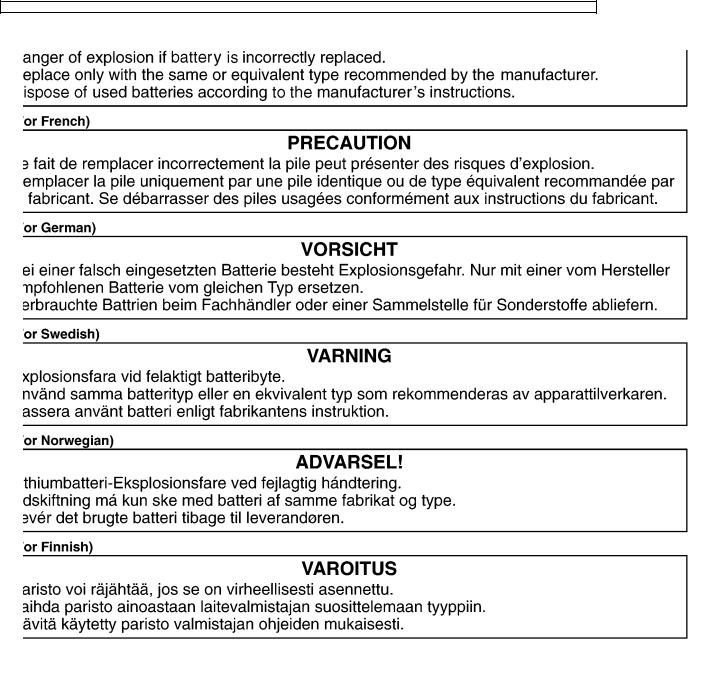
DMC-LZ2PP / DMC-LZ2PL / DMC-LZ2EB / DMC-LZ2EG / DMC-LZ2EGM / DMC-LZ2GC / DMC-LZ2GD / DMC-LZ2GK / DMC-LZ2GN / DMC-LZ2GT / DMC-LZ2SG
NOTE:
Above caution are also applicable for below batteries which is for DMC-LZ2 and DMC-LZ1 all series, as well.
1.AA Oxyride batteries
2.AA Alkaline batteries
3.AA Rechargeable Ni-MH (nickel-metal hydride) batteries
10
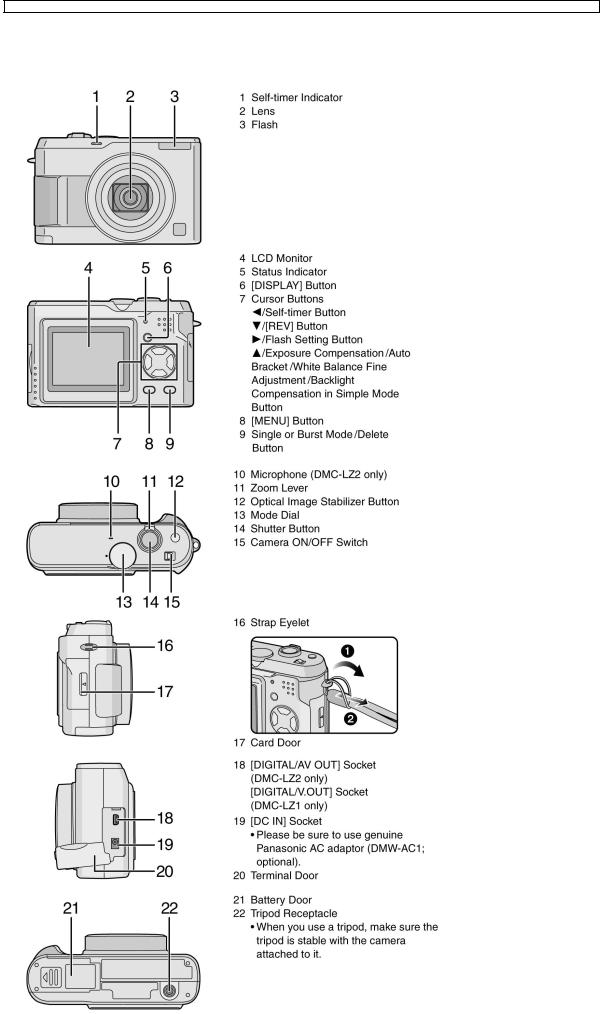
DMC-LZ2PP / DMC-LZ2PL / DMC-LZ2EB / DMC-LZ2EG / DMC-LZ2EGM / DMC-LZ2GC / DMC-LZ2GD / DMC-LZ2GK / DMC-LZ2GN / DMC-LZ2GT / DMC-LZ2SG
5 OPERATING GUIDE
11

DMC-LZ2PP / DMC-LZ2PL / DMC-LZ2EB / DMC-LZ2EG / DMC-LZ2EGM / DMC-LZ2GC / DMC-LZ2GD / DMC-LZ2GK / DMC-LZ2GN / DMC-LZ2GT / DMC-LZ2SG
12

DMC-LZ2PP / DMC-LZ2PL / DMC-LZ2EB / DMC-LZ2EG / DMC-LZ2EGM / DMC-LZ2GC / DMC-LZ2GD / DMC-LZ2GK / DMC-LZ2GN / DMC-LZ2GT / DMC-LZ2SG
6 SERVICE NOTES
6.1.WHEN REPLACING THE MAIN C.B.A.
After replacing the MAIN C.B.A., be sure to achieve adjustment.
The adjustment instruction is available at “software download” on the “CS-Web from AVC” web-site in “TSN system”, together with Maintenance software.
6.2.SERVICE POSITION
This Service Position is used for checking and replacing parts. Use the following Extension cables for servicing.
Table S1 Extension Cable List
No. |
Parts No. |
Connection |
Form |
1 |
VFK1870 |
PP9002 (MAIN) - PS8001 (FLASH TOP) |
30PIN B to B |
2 |
VFK1576DC202 |
P9002 (MAIN) - LCD BACK LIGHT |
2PIN CABLE |
3 |
VFK1582A2125 |
FP9002 (MAIN) - CCD UNIT |
21PIN 0.5 FFC |
4 |
VFK1950 |
FP9003 (MAIN) - LCD UNIT |
33PIN 0.3 FFC |
5 |
VFK1951 |
FP9001 (MAIN) - LENS UNIT |
39PIN 0.3 FFC |
NOTE:
·When the Main C.B.A. is energized, be sure to connect the LCD back light connector (P9002) to the Main C.B.A..
If the Main C.B.A. is energized that the LCD back light connector (P9002) is opened, it may be caused to the case not only the power does not turn on but also transisitor (Q1070) is broken.
CAUTION
1.Be sure to discharge the capacitor for flash, which is connected with FLASH TOP C.B.A. (Refer to “HOW TO DISCHARGE THE CHARGING CAPACITOR ON FLASH TOP C.B.A.”.)
13

DMC-LZ2PP / DMC-LZ2PL / DMC-LZ2EB / DMC-LZ2EG / DMC-LZ2EGM / DMC-LZ2GC / DMC-LZ2GD / DMC-LZ2GK / DMC-LZ2GN / DMC-LZ2GT / DMC-LZ2SG
6.3.HOW TO DISCHARGE THE CAPACITOR ON FLASH TOP C.B.A.
CAUTION:
1.Be sure to discharge the capacitor on FLASH TOP C.B.A..
2.Be careful of the high voltage circuit on FLASH TOP C.B.A. when servicing.
[Discharging Procedure]
1.Refer to the disassemble procedure and Remove the necessary parts/unit.
2.Put the insulation tube onto the lead part of Resistor (ERG5SJ102:1kΩ /5W). (an equivalent type of resistor may be used.)
3.Put the resistor between both terminals of capacitor on FLASH TOP C.B.A. for approx. 5 seconds.
4.After discharging, confirm that the capacitor voltage is lower than 10V using a voltmeter.
6.4.CLEANING LENS AND LCD PANEL
Do not touch the surface of lens and LCD Panel with your hand. When cleaning the lens, use air-Blower to blow off the dust.
When cleaning the LCD Panel, dampen the lens cleaning paper with lens cleaner, and the gently wipe the their surface.
Note:
A lens cleaning paper and lens cleaner are available at local camera shops and market place.
14
